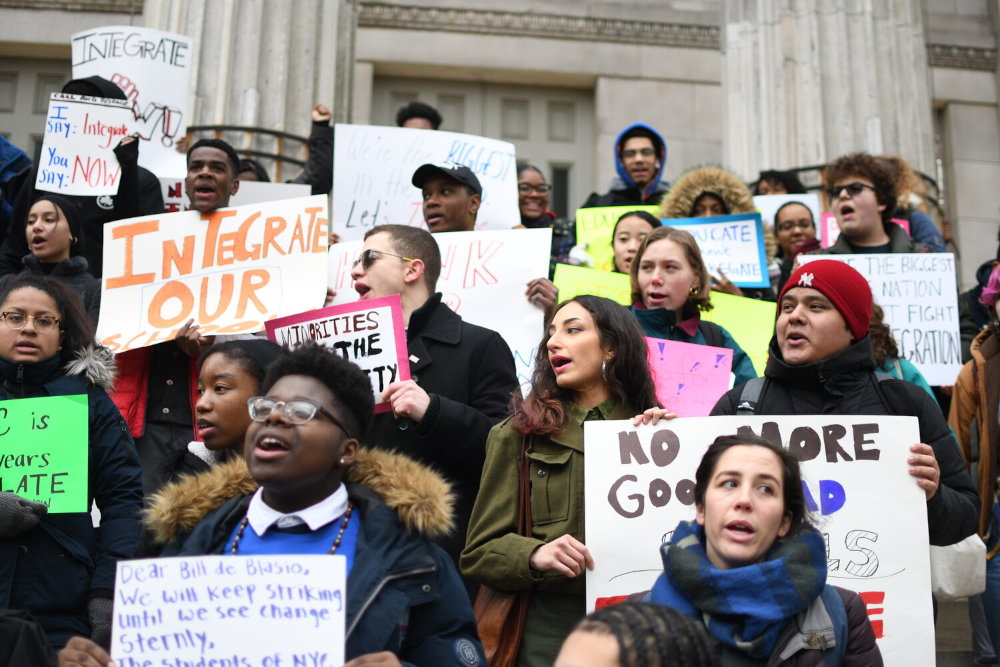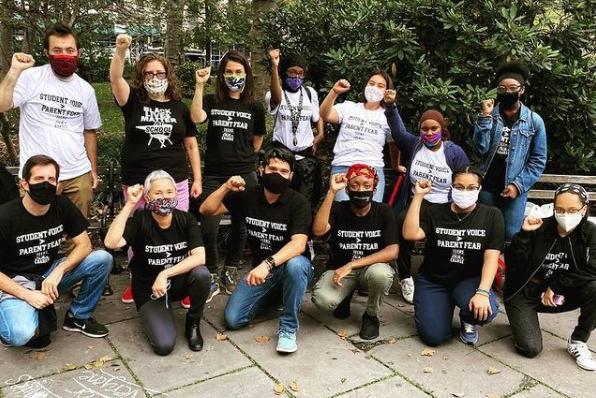Standing at a booth at the annual New York City (NYC) high school fair for middle schoolers from the Bronx, Nina Worley and a friend were surprised by the amount and type of questions that students and parents were asking them. They were representing the high school they both attended, a specialized public institution for the arts. “Are you a private school? Do you offer scholarships?” They were especially startled when an attendee said, “We’ve never heard of you before.”
Worley is a junior at Fiorello H. LaGuardia High School of Music & Art and Performing Arts in the Manhattan borough of New York City, New York, USA. LaGuardia High School is well-known in NYC, so she was disconcerted to realize that some of these students had no idea of the artistic opportunities available at her school.
The NYC high school system is more complex than systems in most other areas of the U.S. Some NYC students simply apply to and attend a high school in their neighborhood, with their admission based on middle school grades and standardized test scores. Thousands of other students apply to one or more specialized high schools, such as the Bronx High School of Science or Stuyvesant High School, which focus on a specific academic discipline (such as science and technology). In order to be considered for admission to these extremely selective schools, students must take the Specialized High Schools Admissions Test (SHSAT). The students with the top scores on the SHSAT receive the first admission offers from the institutions they applied for. LaGuardia is a specialized high school, but instead of taking an academic test, applicants audition (play an instrument, perform a monologue, submit a portfolio of artwork) for a spot in one of its numerous arts programs.
When Worley and her friend were deciding which borough’s high school fair to volunteer at, they saw that no one had signed up to represent LaGuardia in the Bronx or Queens (the five boroughs of NYC are the Bronx, Brooklyn, Manhattan, Queens, and Staten Island). There are almost two and a half times as many African American and over twice as many Hispanic residents of the Bronx as there are in Manhattan. Someone who approached them during the fair mentioned that the Bronx had not seen students representing LaGuardia in years. Worley also noticed that the students at the Bronx’s fair were given very little information about the NYC high school admissions process, including a sufficient overview of the wide variety of schools that were supposedly available to them.
“Students [are] all given a high school book [with] all the [public] high schools in the city… this book is usually gigantic. They were just giving this sliver of a book [at the Bronx fair] with really no good information in it,” Worley said. “Both my friend and I had gone to pretty good middle schools, and I hadn’t registered that other [middle and] high schoolers around the city were not getting the same things.”
This was effectively a wake-up call for Worley, since LaGuardia does not have many students of color.
“When I took a look at who was in my school building, I think that’s when I started really getting into activism. I’m Latina, and my mom’s from Argentina, I speak Spanish… I realized that I was missing a huge part of my identity in my school,” Worley said. “I realized that this was something really important, not just for me, but for other students.”

Nina Worley is a junior at LaGuardia High School in New York City (NYC). She recently joined Teens Take Charge as an organizer for their “Education Unscreened” campaign, whose goal is to remove factors from the high school admissions process in NYC that make it difficult for students from underrepresented groups to attend the “best” schools. Photo courtesy of Nina Worley.
During the summer of 2020, Worley began to search online for organizations that were working to increase diverse representation in NYC’s elite public high schools.
“I was really looking for a student-led organization. Once I kind of felt out the [Teens Take Charge] community and heard more, I reached out to someone. I definitely knew that this was a community I want[ed] to be a part of,” Worley said. “They have different campaigns that you can work on, and I felt that this was a very student-led initiative that didn’t feel hierarchical and felt very open to new people.”
Teens Take Charge’s primary goal is to make NYC’s public high school system equitable, which would mean that it promotes academic success for all students, regardless of their background. They have multiple ongoing campaigns focusing on different aspects of the inequity in NYC, including one working to remove the “screening” system that many high schools, especially the most specialized ones, employ. Worley is an organizer for this campaign, called “Education Unscreened”.
“The specialized schools are like the Ivy League. You need to take an exam to get into [those schools]. They don’t look at your grades, they don’t look at anything except for that test score,” Worley said. “The main issue with… the SHSAT is that the exam covers topics… that [are] not taught in the Common Core, in class. You need outside tutoring; it’s not really an optional thing if you want to do well on the exam. That’s why you see a lot of white students and wealthy students going into those schools.”
The specialized high schools not only provide focused electives in subjects like engineering or visual arts, but they also prepare students for post-high school opportunities, including college.
“The ‘best’ schools, unfortunately, in New York, all screen in a certain sense, and… they have the most resources, the best teachers, the most beautiful classrooms,” Worley said.
Teens Take Charge’s efforts have led to the implementation of multiple critical policies. During June last year, the NYC Department of Education (DOE) created an assembly of students from every high school in NYC to amplify student voices in DOE policy and established restorative discipline (instead of punitive discipline) systems in all schools, among other changes. Punitive disciplinary measures, such as suspension and expulsion, are correlated with high dropout rates and recidivism (committing a violation of school rules again, even after receiving consequences for the first violation). Studies show that students of color are more likely to be suspended or expelled than white peers in the same age group. The restorative discipline system, by contrast, focuses on repairing relationships between teachers and students through discussions of the student’s violation of the rules. However, these measures are only steps on the long path to true school integration and equity.
“Politicians are complacent and that’s where Teens Take Charge comes in… we’re showing them the hard, cold facts. Now we’re waiting for… them to get [it] through their head[s] that there’s an issue in the city and they have the power to control it. If they really wanted to tomorrow, they could… start to fix this problem,” Worley said.

Dozens of high school students from New York City (NYC) stand on the steps of Brooklyn Borough Hall, holding signs calling for integration in NYC’s most selective public high schools. Teens Take Charge organized and led the protest, which took place on Jan. 13, 2020. Photo courtesy of https://www.teenstakecharge.com/unscreen.
Not everyone supports the policies that Teens Take Charge advocates for, especially families whose students are not harmed by, or even benefit from, the current admissions system.
“A lot of students at my school disagree with my opinions about de-screening, and have spoken out against me about it, because they’re [from the] Upper West side… and come from really wealthy families. [They] believe that this is their school and this is their area, and that we should not change it,” Worley said.
When the COVID-19 pandemic spread to the US in the early spring, Teens Take Charge did not stop campaigning for equity. However, social distancing guidelines have shifted Teens Take Charge’s work meetings from in-person to virtual, although they did hold a small gathering outside the NYC City Hall in October 2020.
“Everything we do is on Zoom… but I think [Teens Take Charge does] a really good job of creating community through [activism] workshops, and really making sure everyone feels included,” Worley said. “I feel like I know these people really well, so it doesn’t feel too weird.”

Adult allies and some of Teens Take Charge’s student leaders participate in a protest outside New York City’s City Hall to demand that NYC Mayor Bill de Blasio and other public officials change the current high school admissions process to improve equity for students of color and those from low-income households. Photo courtesy of https://www.instagram.com/teenstakecharge/.
Although Worley is extremely passionate about her work with Teens Take Charge and appreciates the opportunities she has found with the organization, it’s sometimes difficult for her to manage everything: schoolwork, extracurriculars, activism, and a social life.
“The way I’ve had to organize my time has been important, remembering that I’m 16 years old. I can’t save the world in a day, and sometimes I feel like I expect myself to,” Worley said. “But I think I have good friends that, while they’re not involved with Teens Take Charge, I think they do a good job of helping me ground myself and remember [that] I can’t fix the world today.”
Even if Worley and her fellow organizers cannot enact political change by themselves, they believe in the positive impact of their continuing fight for educational equity, now and in the future.
“People call me radical, but I call this change,” Worley said. “This really isn’t radical. This is just asking for equitable resources for everyone.”
